#araceaefamily
Photo

#蔓绿绒 #philodendron #micans #aroid #aroids #aroidlover #araceae #araceaefamily #philodendronmicans #philodendronhederaceum #heartleafphilodendron #velvetleaves (在 Bangkok) https://www.instagram.com/p/CRy6VbYr9sg/?utm_medium=tumblr
#蔓绿绒#philodendron#micans#aroid#aroids#aroidlover#araceae#araceaefamily#philodendronmicans#philodendronhederaceum#heartleafphilodendron#velvetleaves
1 note
·
View note
Photo
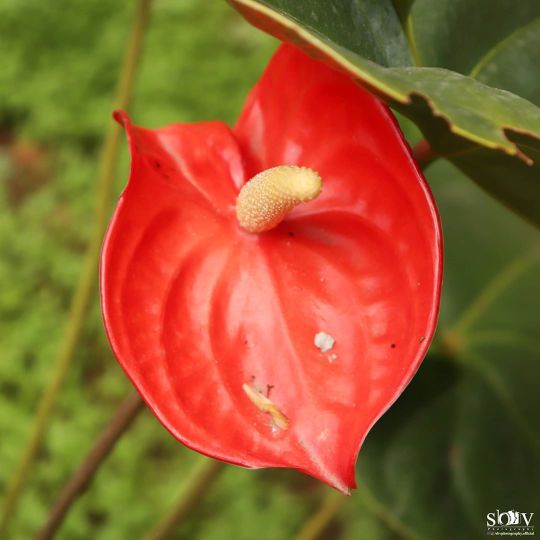
“Flower Grow Out Of Dark Moments”
Anthurium andraeanum is a flowering plant species in the family Araceae that is native to Colombia and Ecuador.
Growing Conditions
Anthurium plants thrive in bright, indirect light. … Anthurium grow in rich, loose potting soil that should be kept moist at all times, but not drenched. Foliage anthurium may produce aerial roots that appreciate misting and the roots can be gently pushed into the soil from time to time.
Source: Wikipedia
Scientific name: Anthurium andraeanum
Kingdom: Plantae
Order: Alismatales
Higher classification: Laceleaf
Rank: Species
Family: Araceae
#sbv#sbvphoto#sbvclicks#sbvphotography_official#sbvphotos#sbvgroups#sbvphotography#anthurium#anthuriumplant#flowers#anthuriumandraeanum#plantae#species#araceae#araceaefamily#laceleaf#flowerphotography#photographyofdslr#photooftheday#photograpgyofflowers#flowerphotography🌸#photoflower#trending#redcolorflower#redcoloranthuriyum#aunthuriyumred#plantkingdom#plantaekingdom
0 notes
Photo

Arum #ambroisecharron #apochrom #arum #whitearum #whitearums #araceaefamily #araceae
0 notes
Text
The surprising truth about counterfeit Dragon’s blood
The truth is you haven’t been buying Dracaena draco, and the surprise is; that’s a good thing.
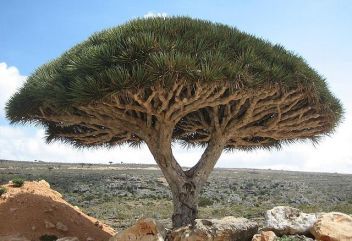
Dracaena cinnabari in it’s native habitat on the Socotra archipelago. Photo credit: Wikimedia commons.
Part one in a series on Dragon’s blood resin.
The other Dragon’s blood; latex, dye and poison
In a modern magical context, Dragon’s blood is often erroneously assumed to simply be the resin sap produced by the Dragon tree, but as with most things in this world, the truth is more nuanced.
The Calamus, Pterocarpus and Croton genera contain plants which produce gums, latexes and resins which have been labeled as Dragon’s blood; these have been used medicinally and as dyes. One example, the latex of the Sangre de drago , Croton lechleri, native to South America, can be used as a natural adhesive bandage.
As for their use as pigments, due to the nature of vegetable dyes, kino gums may resemble blood when oozing from wounds on a tree but often do not produce a red colour pigment.

The familiar kino of the Eucalyptus, Corymbis calophylla. Credit: Wikimedia Commons
Outside of ethnomedical studies and natural remedies, these forms of Dragon’s blood are of less prevalent concern to modern paganism.
Next up we have the brilliant but deadly vermilion, also known as Dragon’s blood, or China red. This was traditionally produced from powdered mineral cinnabar. Cinnabar is a highly toxic form of mercury sulphide which was used in antiquity as a dye, cosmetic and in jewelry. Unsurprisingly you’re not likely to encounter this stuff on the market in its natural form, although vintage Chinese cinnabar lacquered artifacts are attractive to collectors. While cinnabar is very dangerous, with careful handling the lacquer renders it relatively inert.

A wooden plate lacquered with cinnabar. Photo credit: Wikimedia commons
Finally, the form that most of us are more familiar with; Dragon’s blood incense. This is usually derived from either the Daemonorops or Dracaena genera; only the latter of which is also used as a dye.
The true Dragon’s blood tree
The Dragon’s blood resin you see for sale is very unlikely to be from the true dragon’s blood tree. It’s also worth noting that any form of genuine Dragon’s blood essential oil does not exist.
The popular houseplant known as Lucky bamboo, or Chinese water bamboo, Dracaena braunii, is actually a much closer relative to the genuine Dragon’s blood trees. Continuing the theme of misattribution, it is not Chinese nor a bamboo; it’s native to Cameroon in West Africa.
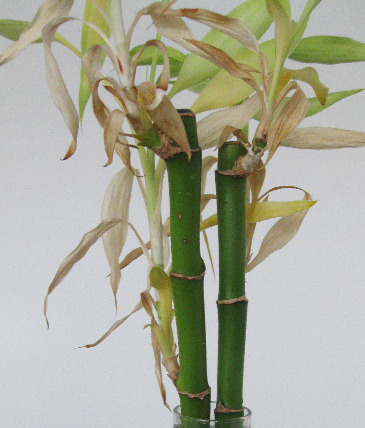
Some lucky bamboo growing on my altar.
The family it belongs to, Asparagaceae, gives us the Agave used in the production of tequila and, as one could guess from the name, the vegetable asparagus.
When people talk about the Dragon’s blood tree, they are usually referring to Dracaena draco or Dracaena cinnabari. Although there are other Dracaena species harvested for their resin, I’ll be focusing on these two as they’re the most widely known and referred to. Due to its distinctive long trunk with leafy branches extending from the crown, these trees are sometimes called a Dragon’s blood palm. This is unfortunate because it is not a palm, while its impostor is.
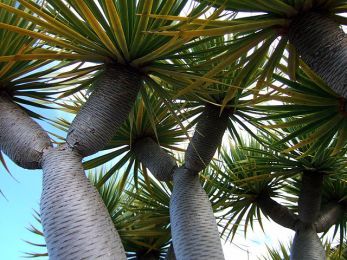
Not a palm. Photo credit: Wikimedia commons
Dracaena draco is a popular ornamental garden tree in Australia, whereas D. cinnabari is much less sought after due to its extremely slow growth rate and similar appearance. Given favorable conditions, the average Dragon’s blood tree takes 10 years to reach a height of just over one meter.
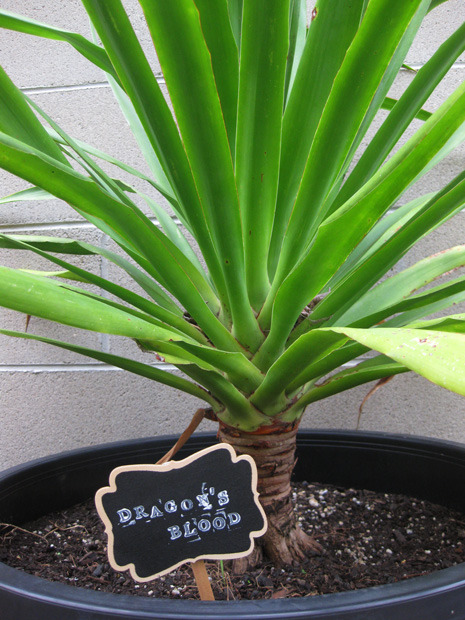
My child. I picked up this D. Draco at Bunnings when it was only 20cm tall. It’s now 3 years of age.
Unfortunately both D. Draco and D. Cinnabari are threatened species; vulnerable to extinction in their native habitats. Both trees have an incredibly slow growth cycle, taking over a decade to reach their first state of reproductive maturity. Habitat loss, over-harvesting, desertification, climate change and modern agriculture techniques all present hazards to their survival.
The common Dragon’s blood cane palm Daemonorops draco, sometimes referred to as Demon cane due to its thorns, is cultivated in Southeast Asia, with much of the resin on the market coming from Indonesia and Thailand. Endemic to the tropics close to the equator, the Arecaceaefamily of plants also gives us raffia and coconuts.
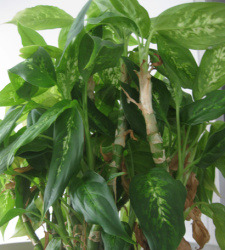
Not to be confused with the Araceaefamily like this Dieffenbachia dumb cane. Because whoever named them hated dyslexic people.
Daemonorops draco is the stuff you’ll commonly see for sale. I often see Dragon’s blood in stores labelled as Dracaena draco, but it’s increasingly rare and difficult to find genuine Dracaena resin.
Although it’s unfortunate that so many otherwise reputable outlets are mislabeling their product, the reasons I posited this as a good thing are threefold. Firstly, Dracaena draco resin, due to its rarity is prohibitively expensive.
Secondly is the issue of the commercial exploitation of an endangered species, making the use of a plentiful alternative attractive. Harvesting Dracaena resin leaves the tree vulnerable to fungal infection which may kill it. Due to this vulnerability and their low numbers, it is favorable that the commonly available Dragon’s blood incense is derived from the plentiful and fast growing Daemonorops draco, as demand for the resin could not be satisfied otherwise.
Thirdly is a matter of personal opinion in regards to their aromatic properties. The rare D. cinnabari and D. draco are almost entirely scentless unless actively being burnt. As Dragon’s blood resin is used in all sorts of aromatic products beyond incense, such as soaps and papers, these would lose their appeal if Dracaena was used in things that aren’t intended to be set on fire.
Conversely the subtle but commanding, warm, masculine scent of Daemonorops draco is quite pleasant and apparent even when not lit.

This red sigil chalk I made using palm Dragon’s blood should definitely not be set on fire.
Now that we’ve established the difference between these three types of Dragon’s blood resin, what about their aromas, magical uses and the mysterious Dragon’s blood ink?
In my next posts I will demonstrate the recipe for Dragon’s blood ink and explore the properties of Daemonorops draco, Dracaena draco and Dracaena cinnabari in greater detail.
1 note
·
View note